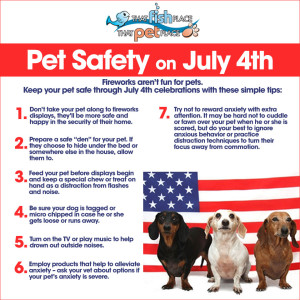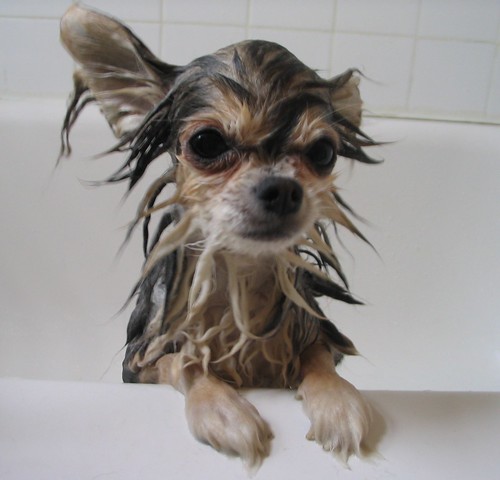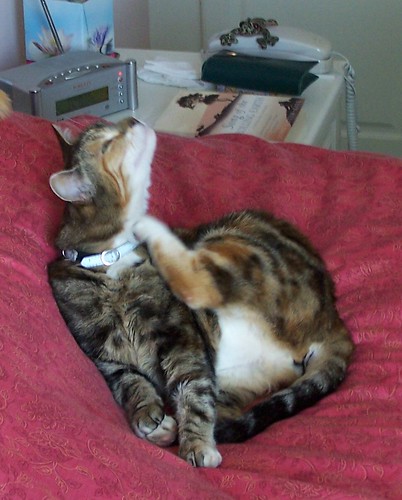The July 4th Holiday is upon us, and unfortunately it is one of the busiest times for animal shelters due to the overwhelming amount of dogs lost during the fireworks & festivities. The fireworks may be fun for us, for some of our canine friends it can be downright terrifying.
During fireworks displays, or even while setting off fireworks in your backyard and neighborhood, your usually calm family pet may become extremely stressed. The stress overload can cause some pets to try to escape the house or yard. By following a few simple tips for this holiday weekend you can avoid coming home to an empty house and the anxiety of a missing beloved family pet.
- Avoid bringing your pet to fireworks displays, even if they are not usually startled by loud noises or thunder.
- Keep your pet indoors in a quiet, safe, sheltered area. Keep doors and windows closed and locked (I’ve heard stories of dogs opening slider doors or even jumping through windows to escape). Leave the TV on or play soothing music at a normal level to distract him from the noise outside
- Prepare a safe “den” for your pet. If they choose to hide under the bed, in their crate or somewhere else in the house, allow them to. If your dog is not crate trained, and you would like him to be please visit our comprehensive crate training guide.
- Feed your pet before the displays begin and keep a special chew treat on hand as a distraction.
- Nervous or stressed dogs may chew to ease anxiety. Make sure to provide proper chew toys and make sure all cords and other dangerous objects are out of reach
- Try a calming aid to help calm anxiety, or ask your vet for medication to help with your pet’s noise phobia.
- Do not leave your pet outside during the festivities. Even with a fence or a tie-out a dog can go to great lengths to escape the source of their anxiety.
- Always make sure your pet is wearing a properly fitted dog collar with up-to-date ID tags. Consider having your pet microchipped for extra security.
- Try not to reward anxiety with extra attention. It may be hard not to cuddle or fawn over your pet when he is scared, but do your best to ignore axious behavior or practice distraction techniques to turn their focus away from commotions.
Follow these simple steps to enjoy a worry free Independence Day. The knowledge that your family pets are safe and sound will make your holiday all the more fun. Have a great holiday weekend!
Severe Weather can also be very stressful on our pets. Check out this post for tips on keeping you pets calm during severe weather.
 That Pet Blog That Pet Place Pet Blog
That Pet Blog That Pet Place Pet Blog


 For those of you following this blog, you may have read some of my previous posts about Gatsby, my incredibly destructive, adopted German Shepherd mix. I’d like to share some of the techniques I used to help curb Gatsby’s destructive tendencies.
For those of you following this blog, you may have read some of my previous posts about Gatsby, my incredibly destructive, adopted German Shepherd mix. I’d like to share some of the techniques I used to help curb Gatsby’s destructive tendencies. Summer is swiftly approaching and many of our readers may be looking for dog-friendly vacation spots. Read on for a list (which is by no means is comprehensive) of pet friendly stops near Central PA. Whether you’re looking to spend a few days hiking the trails with your furry friend or just a day trip in the summer sun your family is bound to enjoy these fun summer destinations.
Summer is swiftly approaching and many of our readers may be looking for dog-friendly vacation spots. Read on for a list (which is by no means is comprehensive) of pet friendly stops near Central PA. Whether you’re looking to spend a few days hiking the trails with your furry friend or just a day trip in the summer sun your family is bound to enjoy these fun summer destinations. It’s important to safe guard your pet against pests that can carry deadly diseases like Lyme disease. However, it is also important to remember that these medications are still pesticides and should be handled with care. The EPA found that some dogs, usually smaller breeds, and cats could have potentially harmful reactions to spot-on flea and tick treatments. Reactions ranged from skin irritation to more severe medical conditions like seizures, and in a few cases, even death. Most of the reactions were caused by “overdose” or using too much of the topical product for the size of the pet. Reactions in cats were typically the result of exposure to a dog- specific formula, either accidentally or through incorrect usage of the product. While the EPA mainly investigated “spot-on” flea and tick treatments, they recommend using caution with all
It’s important to safe guard your pet against pests that can carry deadly diseases like Lyme disease. However, it is also important to remember that these medications are still pesticides and should be handled with care. The EPA found that some dogs, usually smaller breeds, and cats could have potentially harmful reactions to spot-on flea and tick treatments. Reactions ranged from skin irritation to more severe medical conditions like seizures, and in a few cases, even death. Most of the reactions were caused by “overdose” or using too much of the topical product for the size of the pet. Reactions in cats were typically the result of exposure to a dog- specific formula, either accidentally or through incorrect usage of the product. While the EPA mainly investigated “spot-on” flea and tick treatments, they recommend using caution with all  important if your pet is weak, elderly, sick, on medication, pregnant or nursing. You should also carefully read all instructions before applying flea and tick treatments, especially if you have not used the product before. When purchasing a flea and tick treatments be sure to know the current weight of your pets to select the correct product.
important if your pet is weak, elderly, sick, on medication, pregnant or nursing. You should also carefully read all instructions before applying flea and tick treatments, especially if you have not used the product before. When purchasing a flea and tick treatments be sure to know the current weight of your pets to select the correct product.

 The experience has taught me a few lessons, mainly that some dogs really can (and will) eat anything if given the opportunity. I was always very careful about leaving things out or leaving doors open before, but (lesson #2) dogs can be very sneaky. Finally, I learned that both my dogs are integral parts of my life and that when it comes down to the wire I would do anything to make their lives long, healthy, and happy.
The experience has taught me a few lessons, mainly that some dogs really can (and will) eat anything if given the opportunity. I was always very careful about leaving things out or leaving doors open before, but (lesson #2) dogs can be very sneaky. Finally, I learned that both my dogs are integral parts of my life and that when it comes down to the wire I would do anything to make their lives long, healthy, and happy. It’s no secret that your pets need fresh clean drinking water every day for optimum health. It’s also no secret that cats and some dogs are very finicky about, well, pretty much everything! With the warmer weather approaching I want to talk about your pet’s drinking habits.
It’s no secret that your pets need fresh clean drinking water every day for optimum health. It’s also no secret that cats and some dogs are very finicky about, well, pretty much everything! With the warmer weather approaching I want to talk about your pet’s drinking habits.
 When we left off
When we left off  Kongs – I started out using empty marrow bones as makeshift
Kongs – I started out using empty marrow bones as makeshift 